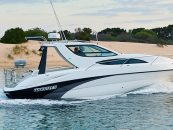Spearfishing takes you to another world. It is almost meditative, as you kick your way through the water, searching for the right spot, calming your body as it screams for air, and waiting for the perfect moment to catch that one, perfect fish. There is no wonder it is a sport popular all over the world.
But before you dive in, there are a few tips I would like to share. I have spent the better part of the last three decades in the water, and want to give any newcomers a bit of a cheat sheet to understanding the sport, and ensure they are starting off on the right foot.
THE SPEARFISHING MENTALITY
Despite the big speargun, most of the spearos (the term we affectionately give to those who enjoy spearfishing) are big nature lovers. Because spearfishing involves getting up close and personal with your prey, you quickly develop a healthy respect for the ecosystem. We are highly selective in the fish we take, only ever enough for our personal needs. Plus, the species and select fish that we target are always within legal catch limits. It is important you follow your local rules and regulations when spearfishing. If you need any special fishing permits, you have to have these, too.
THE RIGHT GEAR
There is no mistake you will need quite a bit of gear to go spearfishing. As a kid, I started in a pair of board shorts, using only a hand spear, a snorkeling mask and a pair of fins. However, with a few more items, it will make your time in the water that much more enjoyable, and also safe. Dive gloves and a wetsuit will help you stay warm, and a weight belt will help you dive to a decent depth. A dive knife is a must. I also recommend a float line and stringer to hold any fish you catch, along with a “Diver Below” flag to notify any nearby boats of your position. Oh, and you are also going to need a speargun!
WHERE TO FISH
Depending on where you live, there will be a few different options for areas you can spearfish. Ask the staff in your local dive or fishing shop for advice, and be sure to research the local fisheries information. You do not want to accidentally end up in a protected zone.
In general, you can spearfish from the shore along the rocks and reef of a headland. There, you will find bream and luderick. Once you start pushing out into deeper water, there will be sweetlip and jewfish, and even the odd crayfish. If you have a boat and can get offshore, this is where it gets really exciting. There is nothing like coming face to face with a school of kingfish in the open ocean.
THE FIRST TIME
Spearfishing is not all that different to snorkeling. Make sure you have found an area that is protected from any incoming swell, and enter the water. I spend the first couple of minutes ensuring my gear is in order, my speargun is loaded and ready, and that I am comfortable holding my breath and duck-dive down to the bottom.
You will also need to practice equalizing your ears as you descend. If it is your first time, I recommend setting up a kelp target on a sandbank, and taking a few practice shots with your speargun. With your arm fully extended, take your sight down the shaft and pull the trigger.
Once you get the hang of it, start scouting around for a good ambush location. Spearfishing is not about chasing the fish – it is about being sneaky. The slowest fish in the ocean is a much better swimmer than you. You need to find a spot you can dive to, and take the fish by surprise – perhaps an overhang, a crevice in the rocks, or a large bit of reef you can circle around.
As you practice holding your breath, it will get easier staying underwater. Do not worry if you do not catch anything on your first couple of dives. Your goal should be to get used to your gear, practising with your speargun, and learning the techniques.
HOW TO TARGET FISH
Once you spot a fish to target, just relax. If you are on the surface, take a deep breath, and dive down to a position you think the fish will swim to. Remember, if you are kicking furiously or making too much noise, you will startle the fish and it will swim away. So stay calm and stealthy.
Once you are in the perfect spot, turn the gun safety off, and get ready with your speargun in your dominant hand. When the fish starts getting close, extend your arm and wait until you have a clear shot. The range of your speargun will depend on the size and model, but in general, you want to be within a few feet of your target.
Line up a spot on the side of the fish. Your goal is for the spear to hit just behind the gills, and go straight through the backbone. Get it right, and the fish will die easily. If you are a little off target, reel the fish in. It will be kicking around attached to your spear. Use your knife to quickly dispatch it and thread it onto your towline. Reload and you are ready to go again.
STAY SAFE
This last point is the most important. The open ocean is a dangerous environment, and whenever you are trying a new sport, it is important to stay safe. Make sure you have a knife in case you get tangled, and a towline that advertises your presence to boats and gives you something to hang on to if you need a break.
But the most important safety rule is to never dive alone. You always need a buddy if you are planning to go spearfishing. Holding your breath underwater can be dangerous if you push it too far, and shallow water blackouts are a real danger if you go too hard. Even experienced spearos never dive alone. My advice is to get a mate involved as you try spearfishing too, and you will also have someone to back up all of your exciting new fishing stories.
For me, spearfishing is the ultimate sport. Chasing bigger and bigger fish is the ultimate adrenaline rush, as you push your own limits and test your ability to take down some real monsters of the deep, often coming face to face with them first. It adds a whole new level to fishing, and also gives you a glimpse into the world beneath the water. I am in awe every time I go spearfishing, and I wish you all luck as you start to explore the sport.
By Max Kelley
Max has been chasing fish in the ocean since he was 15. Through his site, www.maxspearfishing. com, he shares his thoughts and experiences on spearfishing in the big blue sea – oh, and maybe he can help you catch a fish or two!



























